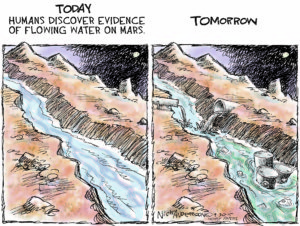‘Flawless’: NASA Craft Lands on Mars After Perilous Journey
Flight controllers at NASA's Jet Propulsion Lab and crowds at viewing parties celebrate InSight's safe arrival for a geological mission.CAPE CANAVERAL, Fla.—A NASA spacecraft designed to drill down into Mars’ interior landed on the planet Monday after a perilous, supersonic plunge through its red skies, setting off jubilation among scientists who had waited in white-knuckle suspense for confirmation to arrive across 100 million miles of space.
Flight controllers at NASA’s Jet Propulsion Laboratory in Pasadena, California, leapt out of their chairs, screaming, dancing and hugging, upon learning that InSight’s had safely arrived on Mars, the graveyard for a multitude of previous missions.
“Touchdown confirmed!” a flight controller called out, touching off a celebration that was a complete turnaround from the nail-biting anxiety that gripped the control room as the spacecraft made its six-minute descent.
Confirmation came minutes later from a pair of tiny satellites that had been trailing InSight throughout the six-month, 300-million-mile (482-million-kilometer) journey.
The two experimental satellites not only relayed the good news in almost real time, they sent back InSight’s first snapshot of Mars just 4½ minutes after landing. The picture was speckled with debris because the dust cover was still on the lander’s camera, but the terrain looked smooth and sandy with just one sizable rock visible — pretty much what scientists had hoped for. Better photos are expected in the days ahead.
It was NASA’s — indeed, humanity’s — eighth successful landing at Mars since the 1976 Viking probes, and the first in six years. NASA’s Curiosity rover, which arrived in 2012, is still on the move on Mars.
“Flawless,” declared JPL’s chief engineer, Rob Manning. “This is what we really hoped and imagined in our mind’s eye,” he added. “Sometimes things work out in your favor.”
NASA Administrator Jim Bridenstine, presiding over his first Mars landing as the space agency’s boss, said: “What an amazing day for our country.”
He said it was a little strange to realize that by the time word arrived, history had already been made eight minutes earlier because of the lag in communication between Mars and Earth.
Indeed, by the time word of touchdown came from space just after 3 p.m. EST, InSight was already well settled on the western side of Elysium Planitia, the flat-as-a-parking-lot plain that NASA was aiming for.
Many Mars-bound spacecraft launched by the U.S., Russia and other spacefaring countries, have been lost or destroyed over the years, with a success rate of just 40 percent, not counting InSight.
NASA went with its old, straightforward approach this time, using a parachute and braking engines to get InSight’s speed from 12,300 mph (19,800 kph) when it pierced the Martian atmosphere, about 77 miles (114 kilometers) up, to 5 mph (8kph) at touchdown.
Flight controllers were relieved to find out promptly that Insight made it to the surface and didn’t burn up in the atmosphere or bounce off it.
Museums, planetariums and libraries across the U.S. held viewing parties to watch the events unfold at JPL. NASA TV coverage was also shown on the giant screen in New York’s Times Square, where crowds huddled under umbrellas in the rain.
The $1 billion international mission features a German-led mechanical mole that will burrow down 16 feet (5 meters) to measure the planet’s internal heat. Nothing has ever dug deeper into Mars than several inches. The lander also has a French-made seismometer for measuring quakes, if they exist on our smaller, geologically calmer neighbor.
Another experiment will calculate Mars’ wobble to reveal the makeup of the planet’s core.
The 800-pound (360-kilogram) InSight is stationary with three legs and will operate from the same spot for the next two years, the duration of a Martian year. Its first job was to get a fast picture out. The next task was the unfolding of its solar panels. NASA wanted to wait 16 minutes for the dust to settle before attempting that; it was awaiting word Monday night on how that went.
Lead scientist Bruce Banerdt warned it will be a slow-motion mission. The instruments will have to be set up and fine-tuned. He said he doesn’t expect to start getting a stream of solid data until late next spring, and it may take the entire mission to really get the goods.
“It really depends on how benevolent Mars is feeling, how many marsquakes it throws at us,” Banerdt said Sunday. “The more marsquakes, the better. We just love that shaking, and so the more shaking it does, the better we can see the inside.”
Mars’ well-preserved interior provides a snapshot of what Earth may have looked like following its formation 4.5 billion years ago, according to Banerdt. While Earth is active seismically, Mars “decided to rest on its laurels” after it formed, he said.
By examining and mapping the interior of Mars, scientists hope to learn why the rocky planets in our solar system turned out so different and why Earth became a haven for life.
Still, there are no life detectors aboard InSight. That will be part of NASA’s next mission, the Mars 2020 rover, which will prowl for rocks that might contain evidence of ancient life.
The question of whether life ever existed in Mars’ wet, watery past is what keeps driving NASA back to the fourth rock from the sun.
Your support matters…Independent journalism is under threat and overshadowed by heavily funded mainstream media.
You can help level the playing field. Become a member.
Your tax-deductible contribution keeps us digging beneath the headlines to give you thought-provoking, investigative reporting and analysis that unearths what's really happening- without compromise.
Give today to support our courageous, independent journalists.



You need to be a supporter to comment.
There are currently no responses to this article.
Be the first to respond.